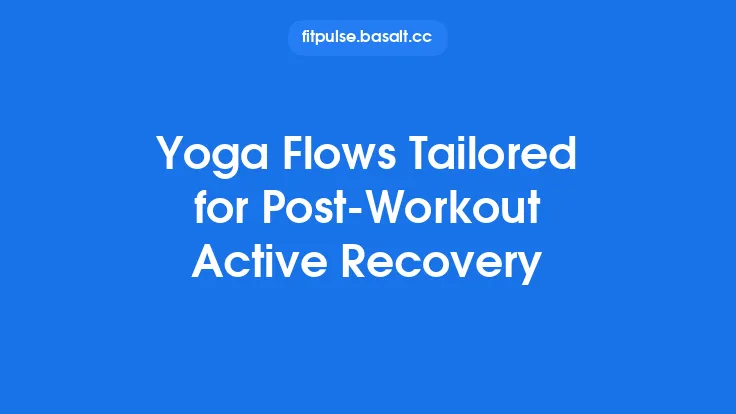Recovering properly after a training session is just as important as the workout itself. While many athletes rush to the next cardio burst or strength circuit, a focused stretch and mobility flow can dramatically accelerate muscle repair, reduce soreness, and prime the body for the next session. The following guide walks you through a concise, equipment‑free routine that can be completed in under ten minutes, making it ideal for anyone juggling a busy schedule but still wanting to reap the long‑term benefits of consistent mobility work.
The Science Behind Post‑Workout Stretching and Mobility
1. Muscle Length‑Tension Relationship
During resistance or high‑intensity training, muscle fibers experience microscopic tears and a temporary loss of optimal length. Stretching immediately after exercise helps restore the length‑tension curve, allowing sarcomeres to realign and reducing the risk of contracture.
2. Myofascial Release and Fluid Dynamics
Dynamic mobility drills promote the movement of interstitial fluid, enhancing the clearance of metabolic by‑products such as lactate and inflammatory cytokines. This fluid shift also supports the delivery of oxygen‑rich blood, accelerating the repair process.
3. Neuromuscular Re‑education
Mobility work re‑engages proprioceptive pathways that may have been temporarily suppressed by fatigue. By re‑stimulating joint capsule receptors, you improve joint stability and coordination for future lifts or sprints.
4. Hormonal Modulation
A brief, low‑intensity movement sequence can trigger a modest release of endorphins and growth hormone, both of which contribute to tissue regeneration and pain mitigation.
Core Principles of an Effective Recovery Flow
| Principle | What It Means | Practical Tip |
|---|---|---|
| Time Efficiency | Keep the entire routine under 10 minutes. | Use a timer and transition quickly between moves. |
| Dynamic Over Static | Move joints through their full range rather than holding a single stretch. | Incorporate controlled oscillations (e.g., 8‑12 reps per side). |
| Full‑Body Integration | Target major movement patterns—hip hinge, shoulder girdle, spinal rotation. | Choose exercises that simultaneously address multiple joints. |
| Progressive Load | Start with low‑intensity mobility, then increase amplitude as muscles warm up. | Begin with micro‑movements, then expand to larger arcs. |
| Breath Synchronization | Coordinate inhalation with expansion, exhalation with contraction. | Use a 2‑second inhale, 2‑second exhale rhythm to enhance relaxation. |
The Speedy Stretch & Mobility Flow (≈ 8‑9 minutes)
Perform each segment back‑to‑back with minimal rest. Use a stopwatch or a phone timer set to the indicated duration.
| Segment | Duration | Key Movements | Target Areas |
|---|---|---|---|
| Warm‑Up Activation | 60 s | Arm circles (forward & reverse) → Hip circles (clockwise & counter) | Shoulders, hips, thoracic spine |
| Hip‑Flexor Mobilizer | 90 s | 1️⃣ Dynamic Lunge with Reach (alternating legs) → 2️⃣ World’s Greatest Stretch (each side) | Hip flexors, glutes, thoracic rotation |
| Spinal Flexibility Circuit | 90 s | Cat‑Cow Flow → Thread‑the‑Needle (each side) → Supine Twist (each side) | Lumbar spine, thoracic spine, core |
| Shoulder & Upper‑Back Release | 90 s | Scapular Wall Slides → Downward‑Dog to Cobra Flow → Band‑less “Y‑T‑W” (on floor) | Deltoids, rotator cuff, upper back |
| Ankle & Calf Mobility | 60 s | Standing Calf Stretch with Knee Flex → Ankle Circles (each direction) | Gastrocnemius, soleus, ankle joint |
| Cool‑Down Integration | 60 s | Deep Diaphragmatic Breathing while lying supine, arms overhead | Parasympathetic activation, overall relaxation |
Total time: ~8 minutes.
Detailed Breakdown of Each Movement
1. Arm Circles (Forward & Reverse)
- Setup: Stand tall, feet hip‑width apart, arms extended straight out to the sides.
- Execution: Perform 10‑12 small circles forward, gradually increasing radius, then reverse direction.
- Cue: Keep shoulders down; avoid shrugging. Engage the rotator cuff by maintaining a slight bend in the elbows.
2. Dynamic Lunge with Reach
- Setup: From a standing position, step forward into a lunge, front knee over ankle.
- Execution: As you lower, reach the opposite arm overhead, creating a diagonal stretch. Return to start and switch legs.
- Cue: Keep torso upright; drive through the front heel to protect the knee.
3. World’s Greatest Stretch
- Setup: From a high plank, step right foot outside right hand.
- Execution: Lower hips, rotate torso, and reach right arm toward the ceiling. Hold 2 seconds, then return and repeat on the left side.
- Cue: Press the back heel into the floor to deepen the hip flexor stretch; keep the spine long.
4. Cat‑Cow Flow
- Setup: On all fours, wrists under shoulders, knees under hips.
- Execution: Inhale, arch back (cow); exhale, round spine (cat). Perform 8‑10 cycles.
- Cue: Move slowly, feeling each vertebra articulate.
5. Thread‑the‑Needle
- Setup: From all fours, slide right arm under left arm, lowering shoulder to the floor.
- Execution: Hold 2‑3 seconds, then return. Switch sides.
- Cue: Keep hips stable; breathe into the upper back.
6. Scapular Wall Slides
- Setup: Back against a wall, elbows at 90°, forearms touching the wall.
- Execution: Slide arms upward while maintaining contact, then lower.
- Cue: Avoid arching the lower back; engage core to keep the spine neutral.
7. “Y‑T‑W” on Floor
- Setup: Lie prone, arms extended overhead (Y), then out to the sides (T), then bent elbows (W).
- Execution: Lift each position 2‑3 seconds, focusing on scapular retraction.
- Cue: Keep neck neutral; squeeze shoulder blades together.
8. Standing Calf Stretch with Knee Flex
- Setup: Place hands on a wall, step back with one foot, heel down.
- Execution: Slightly bend the back knee to target the soleus; hold 20 seconds, then straighten knee for gastrocnemius stretch.
- Cue: Keep hips square; avoid leaning forward.
9. Ankle Circles
- Setup: Stand on one leg, lift the opposite foot slightly off the ground.
- Execution: Rotate the lifted foot clockwise for 8 reps, then counter‑clockwise.
- Cue: Keep the knee stable; focus on full range of motion.
Modifications for Different Fitness Levels
| Situation | Adjustment |
|---|---|
| Limited Mobility | Reduce range of motion (e.g., shallow lunges, smaller arm circles) and increase repetitions to maintain time under tension. |
| Joint Pain or Injury | Replace dynamic lunges with seated hip flexor stretches; swap cat‑cow for seated spinal twists. |
| Advanced Practitioners | Add resistance bands for scapular slides, incorporate weighted vest for ankle circles, or increase tempo to 3‑second holds per rep. |
| Time‑Crunch | Combine movements (e.g., perform arm circles while doing hip circles) to cut total duration to ~5 minutes. |
Integrating the Flow Into Your Weekly Routine
| Day | Suggested Placement |
|---|---|
| Post‑Strength Session | Immediately after the last set, before showering. |
| Post‑Cardio | At the end of a run or bike ride, while the body is still warm. |
| Standalone Recovery Day | Perform the flow in the morning to “wake up” the joints. |
| Evening Wind‑Down | Use a slower version (longer holds, deeper breaths) to promote relaxation before sleep. |
Consistency is key: aim for at least three sessions per week. Over time, you’ll notice reduced delayed‑onset muscle soreness (DOMS), improved joint range, and a smoother transition between training days.
Common Mistakes & How to Fix Them
- Rushing Through Movements – Speed defeats the purpose of mobility. Use a metronome or count aloud to maintain a controlled pace.
- Holding Breath – This spikes intra‑abdominal pressure and limits relaxation. Practice diaphragmatic breathing throughout.
- Over‑stretching Cold Muscles – Begin with the warm‑up activation segment; skip straight to deep static holds only after the body is adequately warmed.
- Neglecting Opposite Side – Always work both sides equally to prevent imbalances.
- Skipping the Cool‑Down – The final breathing segment triggers parasympathetic activation, essential for recovery.
Benefits Beyond Immediate Recovery
- Enhanced Flexibility: Regular dynamic stretching increases muscle extensibility, making future workouts feel easier.
- Injury Prevention: Improved joint mobility reduces abnormal loading patterns that can lead to strains or overuse injuries.
- Performance Gains: A more mobile athlete can achieve better depth in squats, greater reach in presses, and smoother sprint mechanics.
- Stress Reduction: The breath‑focused cool‑down lowers cortisol levels, supporting overall well‑being.
Equipment & Environment Tips
- Footwear: Perform the flow barefoot or in minimalist shoes to allow full foot articulation.
- Surface: A yoga mat or non‑slippery floor provides stability for prone movements.
- Space: A 3 × 3 meter area is sufficient; ensure there’s enough clearance for arm swings and lunges.
- Optional Props: A yoga block can assist in the World’s Greatest Stretch if hip flexibility is limited; a towel can support the calf stretch.
Frequently Asked Questions
Q: How soon after a workout should I start the flow?
A: Begin within 5‑10 minutes while the muscles are still warm. This maximizes fluid circulation and reduces stiffness.
Q: Can I do this routine on rest days?
A: Absolutely. A lighter version performed in the morning can serve as a mobility “maintenance” session.
Q: Is static stretching ever appropriate post‑workout?
A: Yes, but only after the dynamic flow. Holding a stretch for 30‑60 seconds can further improve length, but it should follow the movement‑based segment.
Q: Will this replace my regular stretching routine?
A: It complements, not replaces, a comprehensive flexibility program. Use it as a quick recovery tool; longer, dedicated flexibility sessions can be added on separate days.
Closing Thoughts
A well‑structured, time‑efficient stretch and mobility flow is a powerful ally in the quest for sustainable fitness. By dedicating just a few minutes after each training session to purposeful movement, you nurture your muscles, protect your joints, and set the stage for continual progress. Incorporate the steps outlined above, stay consistent, and let the cumulative benefits of regular mobility work translate into stronger, more resilient performances—whether you’re training at home, in the gym, or on the go.





